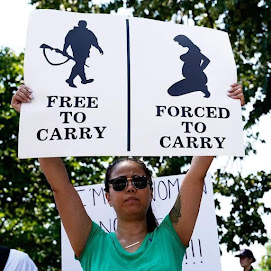Opinion Columnist - New York Times
There is a certain irony in discussions of masculinity. The group that is most convinced of a crisis of masculinity, the American right, is also busy emasculating itself before our eyes. It correctly perceives that young men are facing an identity crisis, yet it is modeling precisely the wrong response.
The release of the Missouri senator Josh Hawley’s new book on manhood is the latest peg for a national conversation about men, but the necessity of such a conversation has been apparent for some time. If there’s anything that’s well established in American social science, it’s that men are falling behind women in higher education, suffer disproportionately from drug overdoses and are far more likely to commit suicide.
Indeed, the very definition of “masculinity” is up for grabs. In 2019, the American Psychological Association published guidelines that took direct aim at what it called “traditional masculinity — marked by stoicism, competitiveness, dominance and aggression” — declaring it to be, “on the whole, harmful.”
I strongly disagreed. Aside from “dominance,” a concept with precious few virtuous uses, the other aspects of traditional masculinity the A.P.A. cited have important roles to play. Competitiveness, aggression and stoicism surely have their abuses, but they also can be indispensable in the right contexts. Thus, part of the challenge isn’t so much rejecting those characteristics as it is channeling and shaping them for virtuous purposes.
I should note here that traditionally “masculine” virtues are not exclusively male. Women who successfully model these attributes are all around us. On my recent visit to Kyiv, I was struck by the restraint and courage of the men and women I met. In the face of the greatest of challenges, they exhibited a degree of calm conviction that’s all too foreign to our domestic politics.
If you doubt the need for such stoicism in our own country, I’d point you, ironically enough, to the side of our political divide that is most critical of the A.P.A.’s conclusions: the American right. In its words, the right claims to uphold traditional masculinity; in its deeds, the story is very different.
Rudyard Kipling’s famous poem “If—” is one of the purest distillations of restraint as a traditional manly virtue. It begins with the words “If you can keep your head when all about you / Are losing theirs and blaming it on you.” The entire work speaks of the necessity of calmness and courage. Do not allow yourself to become too high or too low. (“If you can meet with Triumph and Disaster / And treat those two impostors just the same.”) Persevere.
It’s a compelling vision — although one that can become an emotional trap, to be sure. Stoicism carried to excess can become a dangerous form of emotional repression, a stifling of necessary feelings. But the fact that the patience and perseverance that mark stoicism can be taken too far is not to say that we should shun those values. In times of conflict and crisis, it is the calm man or woman who can see clearly.
Instead, the new right chooses to shriek about “groomers” on Twitter.
If you spend much time at all on right-wing social media — especially Twitter these days — or listening to right-wing news outlets, you’ll be struck by the sheer hysteria of the rhetoric, the hair-on-fire sense of emergency that seems to dominate all discourse.
In 2016, for example, the single most important intellectual work of the new right was an essay by Michael Anton entitled “The Flight 93 Election.” It began like this: “2016 is the Flight 93 election: Charge the cockpit or you die. You may die anyway. You — or the leader of your party — may make it into the cockpit and not know how to fly or land the plane. There are no guarantees. Except one: If you don’t try, death is certain.”
That’s right: The argument was that electing Hillary Clinton, a thoroughly establishment Democrat, would mean the end of America. It’s an argument that people never stopped making. In 2020, I debated the Christian author Eric Metaxas about whether Christians should support Donald Trump against Joe Biden. What did he argue? That Joe Biden could “genuinely destroy America forever.”
Catastrophic rhetoric is omnipresent on the right. Let’s go back to the “groomer” smear. It’s a hallmark of right-wing rhetoric that if you disagree with the new right on any matter relating to sex or sexuality, you’re not just wrong; you’re a “groomer” or “soft on pedos.” Did a senator vote to confirm Ketanji Brown Jackson for the Supreme Court? Then he’s “pro-pedophile.” Did you disagree with Florida’s H.B. 1557, which restricted instruction on sexuality and gender identity? Then “you are probably a groomer.”
But conservative catastrophism is only one part of the equation. The other is meanspirited pettiness. Traditional masculinity says that people should meet a challenge with a level head and firm convictions. Right-wing culture says that everything is an emergency, and is to be combated with relentless trolling and hyperbolic insults.
Twitter, even in its pre-Elon Musk state, seemed as if it had been constructed in a lab to contribute to a constant state of hysteria. Every single perceived left-wing outrage or excess is shared far and wide. “How can you be calm?” right-wing activists demand to know. “Didn’t you see that the North Face is using drag queens in its ads?”
Last month, my friend Jonah Goldberg wrote an important piece cataloging the sheer pettiness of the young online right. “Everywhere I look these days,” he wrote, “I see young conservatives believing they should behave like jerks.” As Jonah noted, there are those who now believe it shows “courage and strength to be coarse or bigoted.”
No one should think that this hysteria is confined to online spaces or that it ultimately remains merely petty or cruel. Hysteria plus cruelty is a recipe for violence. And that brings us back to Mr. Hawley. For all of its faults when taken to excess, the traditional masculinity of which he claims to be a champion would demand that he stand firm against a howling mob. Rather, he saluted it with a raised fist — and then ran from it when it got too close and too unruly.
If the right is going to claim it defends traditional masculinity — through its books, its viral Jordan Peterson videos and its Tucker Carlson documentaries — should it not at least attempt to exhibit the best virtues of traditional masculinity? Yet rather than model the traits of Kipling’s “If—,” the right mimics the attitudes of the countercultural 1968 film “If…,” which offered a sardonic inversion of Kipling’s virtues in its tale of a violent, schoolboy-led insurrection at a British boarding school.
I share many of the right’s concerns about young men. As I argued in one of my first pieces for The Times, American men are in desperate need of virtuous purpose. I reject the idea that traditional masculinity, properly understood, is, “on the whole, harmful.” I recognize that it can be abused, but it is good to confront life with a sense of proportion, with calm courage and conviction.
One of the best pieces of advice I’ve ever received reflects that wisdom. Early in my legal career, a retired federal judge read a brief that I’d drafted and admonished me to “write with regret, not outrage.”
Outrage is cheap, he told me. And he doubted that I, as a young lawyer, had even begun to understand what true legal outrage looked like. Husband your anger, he told me. Have patience. Gain perspective. So then, when something truly is terrible, your outrage will mean something. It was the legal admonition against crying wolf.
I worry for the young right. As Jonah wrote, all too many of them “have no frame of reference, no meaningful political experience or memory of politics prior to this shabby era, they think being shabby is normal and smart.” But there is a better way. It includes paying close attention to the very masculine values they claim to uphold, and it can start with remembering a singular admonition: “Keep your head when all about you / Are losing theirs.” It’s a step toward reason, a step away from the emotional brink and a key to understanding what it truly takes to be a good man.

























